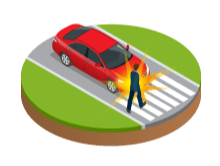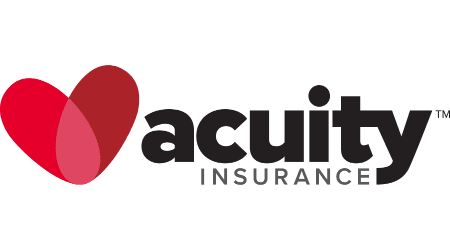Get the cheapest quotes for your car
Compare providers in your area.
Your information is secure
Compare providers in your area.
Your information is secure
Wisconsin drivers pay an average of $830.06 per year for car insurance according to the National Association of Insurance Commissioners (NAIC), that’s about $69.17 per month. Wisconsin drivers pay about 30% less than the countrywide national average of $1,189.64.
The NAIC takes into account all car insurance policies within the state such as drivers who select only state minimum coverage, as well as policies that include various levels of comprehensive and collision coverage. Because car insurance rates are influenced by personal factors, you could find yourself paying significantly less.

In at-fault states, the driver who caused the accident pays for damages.
Drivers in Wisconsin are required to carry a minimum amount of liability coverage to legally drive. You may see it written as 25/50/10, but we’ll break down what that means.

Wisconsin requires $25,000 in bodily injury liability per person and $50,000 of bodily injury per accident. That’s right in line with what most states require for this type of coverage.
This means $25,000 is the most your insurer will pay for a single person injured by you in an at-fault accident. And $50,000 is the maximum amount your insurer will pay if there is more than one person injured by you in an at-fault accident. Any costs outside of your bodily injury limit are required to come out of your pocket.

Wisconsin requires drivers to carry $10,000 of property damage liability to legally drive. This is on the lower end of requirements for this coverage, but it’s common among states.
This means $10,000 is the maximum amount your car insurance company will pay towards damages you cause to another person’s car or property, such as repairs to a car, fence or building. You’ll have to pay out of pocket for any costs beyond your property damage liability limit.

Wisconsin requires all drivers to carry $25,000 of uninsured motorist bodily injury per person, $50,000 uninsured motorist bodily injury per accident. Near half of the states across the US require some sort of uninsured motorist coverage, though some other states let you opt-out.
This coverage protects you if you get hit by an uninsured or underinsured driver. It pays for medical bills to you and your passengers.
These state-mandated requirements are the lowest amount of coverage you need to legally drive in Wisconsin, but may fall short if you’re in a major accident. To avoid high out-of-pocket costs after an accident, consider raising your liability limits by balancing coverage, your budget and what you can afford to pay out of pocket for certain damage.
Wisconsin is an at-fault state, meaning that the driver who causes the car accident pays for the damage. Your insurance company and legal authorities will determine which driver is at fault, based on the details of the accident.
However, Wisconsin also looks at whether both drivers are partially at fault under a modified comparative fault law, according to the legal website Nolo. Under this law, both drivers are assigned a percentage of damage. The driver with over 50% responsibility will pay for the other drivers’ damages. However, the driver with less responsibility isn’t required to pay for any damage.
For example, if you’re 80% at fault for an accident, your insurance will pay 80% of the other driver’s damages. However, since you’re more than 50% at fault, the other driver isn’t required to pay for your damages.
Progressive may be one of your cheapest options, no matter your age in Wisconsin. Young drivers especially benefit from Progressive’s Snapshot program and long list of possible discounts.
| Age | Allstate | Progressive | Geico |
|---|---|---|---|
16-24 | – | $143.24 | $158.25 |
25-34 | $116.94 | $110.43 | $114.69 |
35-44 | $96.81 | $94.67 | $117.65 |
45-54 | $152.10 | $90.93 | $106.46 |
55-64 | $80.80 | $75.81 | $104.38 |
You can pay widely different rates based on your gender in Wisconsin. Men may find the best deal with Progressive, while women may see the lowest rates from USAA according to Savvy’s sample quotes.
| Company | Allstate | Progressive | Geico | USAA |
|---|---|---|---|---|
Men | $108.46 | $100.36 | $123.05 | $143.04 |
Women | $110.87 | $105.67 | $122.40 | $97.59 |
By far, Progressive pulls out the lowest rates among major companies in Wisconsin. We base this cost information on sample quotes from Savvy.
Plus, if you’re a safe driver, you could save even more by qualifying for a claim-free discount or joining Snapshot. Snapshot is a safe driving program that tracks your driving and sets a discount based on your safety.
| Company | Allstate | Progressive | Geico | USAA |
|---|---|---|---|---|
Rate | $110.07 | $103.01 | $122.70 | $127.89 |
In Wisconsin, you get to choose from a variety of national and local brands. We recommend starting with our top picks, which we vetted by looking at coverage, discounts and perks like their online experience.
We also checked each company’s ratings from J.D. Power, Better Business Bureau, AM Best and the National Association of Insurance Commissioners.
Progressive
Finder score
Plus, Progressive rewards safe drivers by cutting up to a third of your car insurance bill if you have a claim-free history. Otherwise, you can join its Snapshot program to show off your safe driving and earn a discount up to 30%.
| Telematics | Snapshot |
|---|---|
| Gap insurance | Loan/lease coverage |
| Telematics | Snapshot |
|---|---|
| Gap insurance | Loan/lease coverage |
Allstate
Finder score
Allstate estimates that you could save 20% over a traditional policy if you drive less than 10,000 miles per year. Or you could pocket up to 66% savings if you drive 2,000 miles a year.
| Telematics | Drivewise |
|---|---|
| Gap insurance | Yes |
| Telematics | Drivewise |
|---|---|
| Gap insurance | Yes |

Acuity
Finder score
Acuity also says that it answers most calls within seconds, and it has a reputation for a quick and helpful claims service. Its app is user-friendly too. Access your policy information, file claims, request roadside service and connect with a local agent or in-network repair shop.
| Gap insurance | No |
|---|
| Gap insurance | No |
|---|
American Family
Finder score
American Family also gets solid customer ratings from organizations like J.D. Power, the BBB and the National Association of Insurance Commissioners (NAIC).
Insurance companies use factors that are characteristics specific to you when calculating your car insurance rate. Less risky factors mean you’ll pay less, whereas factors with higher risk mean you’ll pay more. We’ve broken down Wisconsin’s factor-rating to keep in mind.
| Factor | How it affects your rates |
|---|---|
Age | A driver’s age is one of the main factors insurance companies use when calculating rates. The older you are, the more road experience you have under your belt, so the less risky you are. Depending on the insurer, a 25-year-old driver can expect to pay anywhere between $70 to $500 more annually than a driver aged 35 years. On average, a 25-year-old male can pay $1,210 annually vs. $960 for a 35-year-old male. In contrast, a 60-year-old male can expect to pay around $860 per year. |
Gender | Wisconsin also factors in gender for your rate calculation. The average rate for men is approximately $32 more annually than that for women. Considering other factors weigh in to decide rates for both men and women, typically there’s little variation between gender for companies offering the cheapest insurance. |
Location | Multiple geographic factors comprise car insurance prices, such as accident rates within specific ZIP codes, historic vandalism rates, population density and theft. Drivers in Milwaukee can expect the highest rates at $1,280 on average vs. the least expensive city of Green Bay at $839 annually. The statewide average price for car insurance is approximately $1040 annually. |
Vehicle and mileage | The car model and series level you drive combined with how much you drive also affect your insurance rates in Wyoming. High-powered and high-performance vehicles, and vehicles with aftermarket modifications will see a rise in your insurance. Other factors that decide your rates include overall vehicle cost, the car model’s safety rating and the likelihood of theft. Typically, safer and cheaper models will be less to insure than luxury brands with all the bells and whistles. And the more you drive, the more likely you are to experience an event, which calls for higher premiums. In Wisconsin, driving 6,000 miles yearly equates to $950 in annual premiums, whereas 12,000 on the road will set you back $990. |
Credit score | Wisconsin insurers charge the highest coverage rates for drivers with poor credit histories. Drivers with good credit scores could see an annual insurance rate of about $990. These rates rise to about $1,220 with a fair credit score, and again up to approximately $1,990 for those with poor credit. |
Coverage | Sufficient coverage can mean not having to pay expenses out of pocket in the event of an accident. The more coverage you have, the better protected you are and the higher premiums you’ll pay. Low coverage costs in Wisconsin average to about $960 yearly, whereas high coverage can be anywhere around $1,030 on average. |
Driving Record | Your history on the road makes for important data when determining your car insurance rates. Events like speeding violations, accidents and DUIs can set your premium soaring. Wisconsin drivers with a clean driving record pay approximately $990 annually — or $220 less per year on average — than Wisconsin drivers with one speeding violation. And a driver with a clean history will also pay about $420 less per year on average than someone with one DUI — at $1,410 yearly. |
Yes, Wisconsin can require drivers to file an SR-22 to reinstate their license. An SR-22 is a certificate that proves you have enough car insurance to meet the state’s minimum insurance requirements. The Wisconsin Department of Transportation will notify you if you’re required to get an SR-22, and you may be required to file if your license was suspended or revoked. Learn more about SR-22 car insurance in Wisconsin.
Wisconsin requires 25/50/10 of liability insurance to drive, but the property damage liability coverage is rather low. The state also has a lower theft rate but can experience severe weather – especially in the winter. Here’s some extra coverage you may want to consider.
Most Cheeseheads drive alone to work – 81.7% – as reported by BTS. With high commuter levels like that, it’s wise to consider collision coverage if you’re in that majority. Collision coverage can help you repair or replace your vehicle in the event of an accident, and it’s often required by your auto lender if you’re financing.
Consider collision coverage if . . .
Wisconsin only requires $10,000 in property damage liability coverage to be on the road. While this is common, realistically, it’s not a lot of coverage. If you were to be at fault in a car accident and damage someone else’s vehicle, $10,000 may not cut it. Many newer cars on the road have a value of around $20,000 to $40,000 – trucks and SUVs are likely to be worth more than that. Once the $10,000 steps in to cover damages, anything leftover would be up to you.
Consider more property damage liability coverage if . . .
Storms, cold Wisconsin winters, and abundant wildlife can all represent a risk to your vehicle. Comprehensive coverage can offer peace of mind for things outside of vehicle accidents. If your car is damaged in a storm, hits an animal, or is stolen, then this coverage could protect your wallet from these unexpected, unpredictable events. Comprehensive, like collision coverage, is also required by most auto lenders.
Consider comprehensive coverage if . . .
Wisconsin winters can be brutal, and getting stuck in the cold with a broken-down car only adds insult to injury. To avoid getting stranded, consider adding roadside assistance to your policy. It could be already included in your vehicle’s factory warranty, but it’s likely to expire within five years or 50,000 miles. If you have an older vehicle, live in a rural area, or commute year-round, roadside assistance can offer peace of mind.
We’ve pulled the top 10 companies by market share that offer coverage in Wisconsin according to S&P Global. Compare top companies by three major rating agencies along with our overall score.
| Provider | BBB Rating | JD Power Rating | NAIC complaint ratio | National market share % | Finder score | Go to site |
|---|---|---|---|---|---|---|
A+ | 847/1000 | 1.93 | 16.2 | ★★★★★ 4/5 | ||
A+ | 832/1000 | 1.42 | 13.6 | ★★★★★ 4/5 | ||
A+ | 830/1000 | 1.05 | 13.3 | ★★★★★ 4/5 | ||
A+ | 827/1000 | 2.71 | 10.4 | ★★★★★ 4/5 | ||
A+ | 884/1000 | 1.9 | 6.3 | ★★★★★ 4/5 | ||
Farmers  | A- | 820/1000 | 1.64 | 4.9 | ★★★★★ 4/5 | |
A+ | 827/1000 | 2.2 | 4.7 | ★★★★★ 4/5 | ||
A+ | 814/1000 | 2.08 | 2.3 | ★★★★★ 4/5 | ||
A+ | 815/1000 | 1.35 | 2.1 | ★★★★★ 4/5 | ||
Travelers  | A+ | 820/1000 | 3.28 | 2 | ★★★★★ 4/5 |
Of Wisconsin’s largest cities, Neenah has the cheapest rates and Milwaukee has the most expensive car insurance rates. Milwaukee drivers could face rates 3 times more than Neenah drivers.
Company | Annual car insurance rate |
|---|---|
| Allstate | $2263 |
| American Family | $1550 |
| 21st Century | $1835 |
| Metromile | $1871 |
| AAA | $2666 |
Company | Annual car insurance rate |
|---|---|
| Allstate | $1350 |
| American Family | $1153 |
| 21st Century | $1355 |
| Metromile | $1105 |
| AAA | $1861 |
Company | Annual car insurance rate |
|---|---|
| Allstate | $1296 |
| American Family | $1243 |
| 21st Century | $1275 |
| Metromile | $1121 |
| AAA | $1892 |
Company | Annual car insurance rate |
|---|---|
| Allstate | $1376 |
| American Family | $1224 |
| 21st Century | $1372 |
| Metromile | $1148 |
| AAA | $1968 |
Company | Annual car insurance rate |
|---|---|
| Allstate | $1325 |
| American Family | $955 |
| 21st Century | $1170 |
| Metromile | $837 |
| AAA | $1749 |
Car insurance can help to protect you and your vehicle, plus other drivers on the road — and in the state of Wisconsin, you simply can’t hit the road without it.
To learn more about these topics, from state laws and regulations to finding the best value on your coverage, visit our comprehensive guide to auto insurance.
Fast funding with a catch — find out if PayDaySay is worth it for short-term emergency loans.
A review of Cash Loans Express, a loan connection service that raises numerous red flags.
A review of MoneyKey, a lender that offers installment loans and lines of credit up to $3,500 to borrowers with poor credit.
APY stands for “annual percentage yield” and factors in compound interest. See why the difference between APY and interest matters so much.
Interest-bearing accounts passively grow your money. Compare common types of accounts that earn interest and find the best one for you.
Try to keep enough money in your checking account to cover monthly expenses, plus a small cushion. Read more tips here.
The Chime Credit Builder Card can help you build credit without charging interest and doesn’t require a deposit or monthly fee.
Explore cash advance apps like Ualett, perfect for gig workers looking for quick funding, budgeting support and flexible borrowing options.
A review of CashUSA, a loan connection service that may match you with lenders offering loans up to $10,000.
Explore different ways you could earn money playing games with GPT apps, Twitch streaming, esports competitions, and trading cards.